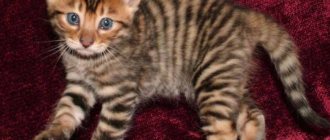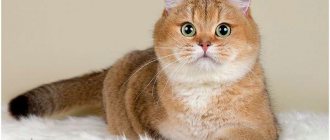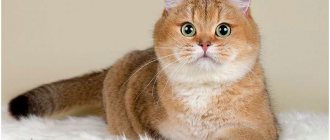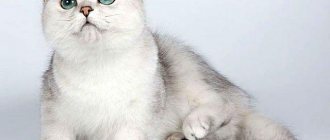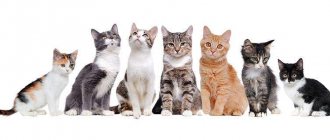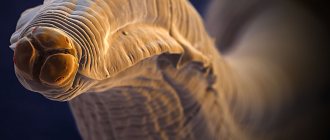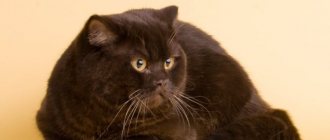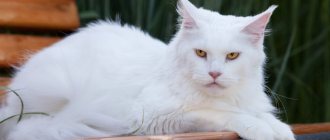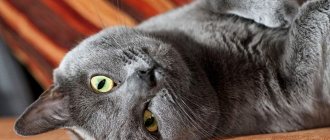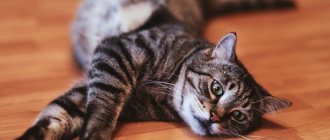What does tabby color mean?
The unusual name “tabby” (translated from English tabby) means “motley, spotted, striped.” This intricate coloring is also called patterned or patterned because of the brightness and contrast of the colors.
This is the most ancient and diverse type of animal fur coloring. Moreover, only members of the cat family have tabbed color. No other representative of the animal world can boast of such an unusual pattern on its skin.
Tabby coloring is a natural color in cats. Stripes and spots of various shapes and sizes were observed on the fur of the distant ancestors of these animals. This kind of camouflage helped them become invisible among bushes and dense thickets. Thanks to camouflage coloring, large predators could easily get close to their prey, while smaller forest cats could escape from their enemies.
Tabby coloring is often called wild. After all, almost all representatives of the cat family living in their natural environment have stripes or spots.
Thanks to domestication and the hard work of breeders, many other interesting colors of purring pets have been developed today. But still, motley, wild color remains the most common among cats of different breeds.
Recognizable appearance
The British cannot be confused with anyone else: a muzzle with a weakly defined “stop” and slightly rounded ears, huge eyes of a predominantly golden color and large cheeks that just want to be squeezed. And because of their plush fur, you don’t want to let go of them at all. Short-legged, with a massive body weighing on average 5-7 kg. The coat comes in both long and short hair.
British Shorthair
They have a short and thick six with a healthy shine. It feels elastic and soft to the touch.
British Longhairs
Six british longhair of medium length with thick undercoat. Feels more “plush” than British Shorthair cats.
striped british photo:
Color standard
The variety of cat colors never ceases to amaze. But there are standard distinctive features that are required for tabby cats:
- an “M” sign appears on the forehead between the eyebrows;
- the eyes and nose are edged with a thin line, thanks to which they stand out on the muzzle;
- on the stomach - individual spots placed in rows;
- on the neck there are continuous stripes, similar to a necklace;
- paws and tail are covered with ring-shaped stripes;
- the contrasting pattern is clear and bright;
- pets with a silver tint of fur have green eyes;
- other tabby cats have warm-colored eyes (lemon, copper, orange, brown, amber).
With all these standard characteristics, it is impossible to find two cats with exactly the same pattern.
Originality, brightness, uniqueness and originality of color - these are the characteristics that are valued by knowledgeable lovers of tabby-colored pets.
The Case of the Redheads
Spotted cat - examples of breeds and their names
However, there is an exception to this series. The fact is that the influence of the “non-agouti” allele on the “O” (“Orange”) gene is excluded. It is because of this that naturally occurring ginger cats (cream-colored) should have such an intriguing tabby coloring. Meanwhile, the “solid” cream color (very wide, differently colored stripes, as if identical to the human eye) is the result of long-term work by breeding specialists.
Important! All "furry enigmas" potentially have tabby coloring in their genetic "menu". Evidence of this is the residual effect in many kittens (“ghost”, baby tabby). However, after molting, it becomes uniformly colored throughout its entire body. Consequently, not all cats exhibit genotype “A” (agouti), which is what leads to the desired effect.
Types of drawings
Felinologists (specialists in the breeding and selection of cats) distinguish 4 basic types of patterns inherent in the tabby color:
- ticked (Abyssinian);
- striped (mackerel);
- classic (marble);
- spotted (leopard).
Ticked
The most inconspicuous, barely distinguishable tabby color is ticked.
The color of the coat of such a pet is almost monochromatic. But, if you look closely, you may notice slightly visible stripes, small marks or small “freckles” that differ from the dominant background of the cat’s fur by a couple of tones. A pronounced, clear pattern is observed on the muzzle, chest, paws and tail of the animal.
The ticked color option is typical for Abyssinian cats. Hence the second name for this tabby color – Abyssinian.
Striped
If there are expressive narrow lines on the cat’s fur, then the color is considered striped, brindle (due to its resemblance to a tiger).
Vertical stripes are distributed parallel to each other, starting from the spine and going down to the stomach in many branches. The stripes stand out against the main background in a contrasting color.
Another name - mackerel - the pattern received due to its similarity with the coloring of mackerel - a striped fish.
Classical
The classic tabby color is considered the most beautiful.
The graphic patterns on the paws and neck of the animal are not very clearly expressed. The back and sides of the cat are decorated with interesting large spots, various curls and wide stripes.
Thanks to the contrasting color, intricate figures stand out well against the dominant tone ─ any tone other than white. This color is also known as “marble”.
Spotted
The spotted color type is defined by felinologists as leopard print. It is characterized by patterns that consist of specks and specks. A drawing of a relatively dominant color may be bright or not very different in tone from the base. An animal with this pattern looks like a small leopard.
Rarer variants
There are cats with rare tabby colors. Such colorings are an exception and do not fit into the main classification of tabby types:
- rosette: reminiscent of leopard print. Large spots with a dark outline look like irregular circles with a light center. The colors of the pattern contrast with the main background of the wool;
- tortoiseshell: characterized by the presence of two colors in the color of the animal (mainly yellow and black shades). The spots are not very bright, located in a chaotic manner;
- Calico: another basic tone is added - white. The pattern consists of short stripes and spots located on the pet’s paws, neck, muzzle and tail. The Calico tabby color is also called "spotted and white";
- patched: unusual coloring combines tortoiseshell and calico. A fairly large pattern of spots of different colors resembles patches;
- Links point: the pattern covers only some parts of the body (ears, muzzle, limbs, tail, chest or spine area). The body of a pet with a lynx point color is one color.
Tabby calico kitten
Origin story
There is an opinion that the ancestors of the Siberian cat were Norwegian forest cats, which were brought to the country by settlers. Written sources from the 16th century mention Bukhara cats - large, strong animals with thick hair and an independent character. You can agree with both the first and second versions, as well as refute both. But one thing is known for sure: in 1986, breeders began to select for breeding the so-called “native” Siberian type: large, fluffy and with powerful paws.
Animals fell into their hands simply: local residents brought their own animals to participate in the experiment. Gradually, breeding work began in the Far East and Siberia. In 1991, WCF adopted the standard developed by felinologist Olga Mironova. After 5 years, the breed was recognized by TICA and FIFe.
Currently, there are several large centers for breeding Siberian cats in Russia: in Moscow, St. Petersburg, Saratov, Yekaterinburg, Kirov, Petro was gradually identified as a separate breed.
A kitten without a pedigree costs about 10-20 thousand rubles, with documents - up to 40,000 rubles.
Tabby colored breeds
Tabby coloring is natural among furry domestic predators. There are more than 20 cat breeds for which this color is considered standard. For some cats, patterned coloring is the only option.
However, each individual breed has specific tabby color requirements.
Abyssinian
According to the standard, Abyssinian cats are supposed to be ticked in color. Your pet's short-haired coat may have a uniform blue, copper or orange color. Variations of these tones are allowed.
The muzzle, tail and paws have typical tabby patterns. Eyes and nose - with clear contours. It is obligatory to have the “M” sign on the forehead. The inside of the belly and limbs may be lighter than the base color.
There may be white spots on the chin and chest. A dark line runs along the ridge to the tip of the tail. Eye color is greenish or yellow-orange.
British
British breed kittens are born tabby when at least one of the parents is tabby or spotted. Small British cats usually have a clear and contrasting pattern on their fur, but as they grow older, the pattern seems to blur. Only at the age of 1 year can you see the true tabby coloring of a British cat.
All types of tabby colors are found in animals of this breed. The British cat is often tabby. The brindle British cat has an interesting feature: the main light color of the coloring runs along the spine of the animal.
Clear, pronounced drawing of patterns is the main requirement of the standard. The brindle british must have orange or copper eyes. The classic color scheme of British cats is very beautiful and unique.
The tabby-colored British merle is covered with large patterns of different color shades. The drawn figures are not interrupted or intersect.
In British tabby cats, ticked colors are also possible. The color of the pet is almost uniform, but the fur on top seems to be covered with a coating. Ticked British dogs can be chocolate, black, or blue.
The silver British pet can be a leopard tabby color (dark markings on a light tone). The eyes of these cats are usually hazel or emerald green.
Whatever type of color a British cat belongs to, it must have the basic characteristics of a tabby color.
Scottish
The coat color of the Scottish cat breed can have different color combinations:
- black pattern on a silver background;
- brick-red stains on a light red base;
- black stripes on chocolate brown coat;
- beige colored markings on a dominant cream base.
Tabby patterns are observed on the skin of the brindle, spotted or merle type. There must be an indispensable mark on the forehead, outlined eyes and nose. The tail and paws are decorated with rings, and the chest and neck are decorated with a necklace.
The cat's eyes match the main color of the coat. They come in amber, yellow, emerald or blue. Some individuals with a light color have different eyes.
Singaporean
All representatives of the Singaporean breed are characterized by a single possible color. The base background is light, close to ivory. Brownish or dark gray streaks are visible on it. There is a dark stripe on the spine that runs along the cat’s tail.
The spots on the animal's belly, chin and chest are lighter. There is an intermittent pattern on the muzzle. Eyes with green or yellow irises. Sometimes these shades mix and give an interesting yellow-green color to the eyes of Singaporeans.
Siberian
The Siberian kitten is usually covered with stripes and spots, which is characteristic of the wild color. The main coat color is most often gray-brown and is an excellent camouflage.
The eye color of Siberians is light yellow or green. There is an “M” sign above the nose.
The following types of tabby colors are distinguished among the Siberian cat breed:
- classic tabby pattern - large, clear markings;
- brindle tabby stripes - thin drawn lines;
- leopard tabby – spots of different shapes and sizes;
- patched tabby - beautiful patch markings of different colors (gray with blue, brown with cream).
The fur of this cat breed is quite long. Its top layer is waterproof, and the bottom layer, the undercoat, is very thick and warm. This coat protects animals in severe frosts. The furry paws of Siberians are also covered with fur between the toes. Therefore, animals move easily on snow and ice.
Persian
Persian kittens come in all sorts of tabbed colors. But only brown, orange and silver shades of wool are recognized as standard. In this case, all the necessary signs of tabby color are present.
The eyes of a furry pet should be combined with the dominant background of the fur coat. They can be green, hazel or copper in color.
Thai
Thai cats are very similar to Siamese cats.
Individuals with the tabby color of a rare variety - lynx point - are distinguished. Markings of various colors are visible on the pet's light coat. Depending on the tone of the stripes, there are several subtypes of linx point colors:
- black pattern – seal-links-point;
- gray-blue pattern - blue links point;
- milk chocolate markings – chocolate lynx point;
- orange stripes - orange links point.
At the same time, the drawing is well outlined. The obligatory features of the tabby color are present (the nose and eyes are lined, the “M” pattern on the forehead, the paws and tail are decorated with unfinished rings). There are spots in the mustache area.
Egyptian Mau
The short-haired pet of the Egyptian Mau breed is medium in size, spotted in color. Moreover, not only the cat’s fur is covered with spots, but also the skin.
A purebred representative of this breed exhibits the main characteristics of a tabby color. The letter “M” on the forehead and above, at ear level “W” - this mark is called the scarab sign. Spotless in size and shape, scattered throughout the body in disarray. The upper part of the front legs are in “bracelets”.
The eyes are large, green, outlined with a clear line that continues along the cheekbones to the sides.
Ocicat
Ocicat cats are bred as a result of mixing spotted breeds. They have leopard print colors, where the main background is blue, red, and beige. Contrasting marks are applied to the background in a chaotic manner.
There are intermittent stripes running down the back. The sides and belly have light markings. The darkest pattern is on the face, paws and tail.
The Ocicat has eyes of any color except blue and blue. A purebred pet is an exact copy of a wild leopard, reduced in size.
Asian
The Asian cat, contrary to its name, was bred in England. The breed belongs to the group of short-haired animals.
Asian cats appeared as a result of crossing the Burmese and the Persian chinchilla. Experimental breeders have identified the following individual breeds:
- a cat with a solid color;
- smoky cat;
- Asian tabby;
- tiffany;
- Burmilla.
All of them were united by a common name - Asian cat.
In the 90s of the last century, the Asian breed of tabby cats stood out as a separate breed. Such animals are not very common. Therefore, the price for a purebred Asian cat is quite high (up to 1000 US dollars).
The basic color tone of rare pets can be varied:
- reddish;
- light blue;
- Dark red;
- cream;
- lilac;
- apricot;
- tortoiseshell;
- black.
Based on the location and types of patterns on the skin, an Asian shorthair cat can have any of the existing basic tabby colors: leopard, marbled, ticked, brindle.
If there is a piebald color and the absence of pronounced tabby markings on the face, an Asian cat may be disqualified and not admitted to the exhibition as a purebred representative.
Mongrel cats
Domestic cats that are not purebred are most often tabby in color.
At first, inconspicuous, mongrel kittens, growing up, turn into real beauties with a unique color. It is the yard animals that can amaze with the variety of designs and patterns on their skin. It is not possible to repeat some of the most beautiful colors even in the course of purebred breeding work.
Behavior, temperament
Everything about Siberian cats is magnificent: a proud head carriage, an open and expressive look, regal manners and stature, a luxurious fur coat and a bushy tail. Behind this brilliant appearance lies an unusually good-natured and balanced character.
Representatives of the breed are not characterized by arrogance, touchiness, or vindictiveness . They are very sociable, sociable, flexible, and have a sincere and lasting attachment to their owner. Intuition and natural intelligence help cats subtly perceive a person’s mood and feel the need for their own presence.
This is interesting! The agility, exceptional reaction, and ability to make incredible jumps and climb to heights, inherited from their forest ancestors, make Siberian cats indispensable partners in outdoor games and fun.
Unusually playful in childhood, Siberian cats retain this quality throughout their lives. Pets are highly trainable, always know what is wanted from them, and willingly meet reasonable demands, as long as their self-esteem does not suffer. Neighborhood in the house with other cats is not a problem for Siberians: thanks to their innate fearlessness and leadership qualities, they always head the hierarchy, maintaining obedience and order among their relatives.
But with regard to small animals, such a compromise is unlikely to be achieved: the indomitable hunting instinct of Siberian cats cannot be suppressed. They are wary of strangers and may show an intention to defend their territory and give a worthy rebuff to the enemy, if necessary.
Return to content
Possible tabby colors
It should be noted that tabby is precisely the pattern on the animal’s fur. The main background against which these patterns stand out can be completely varied. The color of the cat's nose and paw pads corresponds to the basic tone.
There are several common tabbed colors.
Brown
A cat with a brown tabby color has patterns on his coat that are covered with completely black hair - it resembles the color of coal soot. And the main color of the coat is copper-brown.
The animal's nose has a red tint and is outlined. The pet's tail is covered with spots in the form of rings - this is generally a distinctive feature of the tabby color.
Lilac
On a light lavender background there are gray spots, as if dusted with frost: this is a lilac tabby. The iris of his eyes is yellow or orange. This color is quite rare.
The lilac Briton can boast of such an exotic coat.
Silver
On a light gray background there is a black pattern of curls, stripes and spots: this is a silver tabby color. There are variants of red-silver colors: on a silver-cream tone there is a reddish pattern.
Silver cat
Red
Red tabby is also called marmalade color. It is characterized by pronounced red markings on a lighter red background. The eyes of such a cat are orange, copper, yellow, brown with a dark red outline.
brindle
The brindle color of the tabby brings the cat closer in appearance to a real predator from the cat family - the tiger. Pronounced stripes are clearly colored, usually their color contrasts with the main background.
Blue
The main background of this color is delicate beige. On it are figures of blue or gray shades. At the same time, the eyes are yellow-orange tones with blue eyeliner.
Marble
Very beautiful color. So called because the shape of the stains and patterns resembles the pattern on marble. The spots are large, well-defined, do not merge or connect with each other.
Cream
Spots and stripes of peach or sand color on a mostly pale cream background are a characteristic feature of the cream tabby color. The eyes are outlined with a dark pink stripe.
Chocolate
The pattern is characterized by a rich chocolate color on a light milky coffee background. The iris of the eyes with this color is yellow or brown. The nose is dark brown or brick red.
Other color options
| Color name | Color of stripes and spots | Dominant shade |
| Amber | Black smoky | Peach |
| Bronze | Chocolate dark | Warm creamy |
| Chestnut | Brown bright | Cream or orange |
| Golden | Black | Light milk chocolate |
| Cinnamon color | Chocolate light with red tints | 2-3 tones lighter than the pattern |
Genetics of color
In the genetic code, absolutely all cats have the T (tabby) gene, which means that initially they are all tabbies.
But the pattern on the animal’s skin is not always observed. There is another gene, agouti (A), which affects the color of cats and the appearance of patterns on the animal’s coat. The amazing agouti gene colors each hair in different shades. The colors alternate in the form of transverse dark and light stripes.
When agouti is dominant (AA), the hairs in the dark areas are denser in color. There is less coloring pigment in the lighter areas. A tabby pattern appears with a noticeable color contrast.
If the gene is recessive (aa), the animal’s coat is monochromatic. In this case, the pigment granules are distributed evenly and color the hair equally along the entire length. It turns out that agouti does not affect the pigmentation itself, but is responsible for the distribution of colors on each individual hair.
Another gene, melanin, is responsible for the color of the pigment. It is the amount of this substance that determines the color of the animal’s eyes, skin and fur.
Cat character
The character of the Siberian cat is multifaceted, they are moderately curious, and despite their enormous size, they amaze with their affectionate nature, but at the same time they are completely unobtrusive animals. They are descendants of Siberians and sometimes show a strong capricious character. Loyal to the owner and family, they have distinctive behavioral traits:
- Dogs and other pets are treated friendly. But it is dangerous to have birds and rodents in the house as pets; Siberians are famous hunters and have not lost their hereditary instincts. No wonder they were famous in Siberia as the best rat catchers.
- This is a breed of cat, similar in character to dogs and also protect their territory, and if necessary, if other animals become aggressive towards them, they will be able to fight back, bite, and scratch.
- In the house their behavior is active, just like in nature. They love to climb higher; they have access to high cabinets, shelves and even chandeliers. Climbing higher and watching what is happening is their favorite pastime.
- Siberian cats that originally grew up in nature need frequent walking, especially if they live in an apartment. They are well versed in the area and can walk independently and will always find their way home.
- In country houses there is especially room for them; they love to explore new territories, they are physically active, they love to climb trees, catch birds, and there will be no rodents left in the area.
- They are playful with small children, love to play around, but do not allow themselves to be pulled by the tail. They can use any object as a toy.
- Siberians are subject to moods and can behave capriciously; it is useless to pick them up if they do not show desire. They are not very talkative and you rarely hear meows from them.
- Watching Siberian cats is interesting and funny, especially when they sleep, lounging on their backs with their paws raised, like a dog.
Interesting Facts
Many newborn kittens have stripes and spots on their fur, despite the fact that the parents are the same color. Over time, the drawing disappears. However, this fact confirms that all cats are tabby by nature.
Ticked males and females can produce babies of all four main tabby color types. If the parents are spotted-striped, the birth of the same kittens or pets with a merle color is possible.
But from marble males and females only the same kittens with the classic tabby coloring will appear. Some experts are sure that tabby cats are the most affectionate, well-mannered, intelligent and very sociable. They are closer to the wild, so they grow up to be excellent hunters.
The tabby color is not only common among cat breeds, but is also very popular among lovers of mustachioed pets. English animal breeders claim that striped and spotted kittens are bought more often than solid ones.
Genetic properties and anti-properties
It is this gene that has such a valuable property of brightening up any hair of a cat’s fur in a special way, alternately alternating transverse stripes of different colors (dark, light). If in dark areas there is a significant concentration of a pigment called eumelanin, then in light stripes there is much less of it. The spherical granules of this version of melanin, which reflects light waves in the yellow-orange range, have the peculiarity of elongating and taking on the shape of an ellipse, located along the entire length of the hair. Which causes the desired effect, as a result of which a tabby cat appears.
Tabby cat breed (Siberian)
If the cat’s genotype contains the so-called “homozygous” allele (“non-agouti”), then the tabby coloring does not appear. The allele suppresses and masks tabby genes. As a result, the color of the cat's fur turns out to be completely the same (epistasis).
Definitions
Agouti is a phenomenon of zoned hair coloring. Each hair is divided into several zones, each of which is colored to varying degrees: some zones are more intensely colored, others less or not colored at all.
Ticking is a zonal hair coloring that is formed by alternating two deposited pigments - black and yellow. This trait appears only if there is an agouti factor in the animal’s genotype, that is, a dominant allele of the Agouti gene.
Tipping – coloring the upper part of the hair with complete or partial depigmentation of its lower part.
Solid (Solid, monochrome, plain) colors. There are only 3 main (not lightened) solid colors and 3 lightened ones. The main colors are: black, red and chocolate, a lighter brown color is very rarely found - the so-called cinnamon color (or cinnamon), but since this phenomenon is not very common, this color does not belong to the main ones.
Each of the main intense colors has its own lightened version: for black the lightened analogue is blue, for chocolate - lilac, for red - cream.
All of these color variations have a completely painted nose mirror, each hair is evenly colored and the pattern does not show up; although a small residual tabby may sometimes be noticeable in some young (up to 10 months) animals, especially lighter colors.
Separately, it is necessary to stipulate the presence of a more or less intense residual pattern in red and cream colors. In terms of phenotype, the colors red and red patterned (cream and cream patterned, respectively) are often practically indistinguishable. In this case, it is possible to conclude what kind of color it is only by analyzing the ancestors and descendants.
For all monochrome colors, first of all, it is important to have a uniform, uniform coloring of the coat from root to tip. For intense colors, the brighter and more saturated the color, the better; for lightened colors, on the contrary, a lighter and more delicate shade is preferred. But in all cases, the main thing is uniformity. Disadvantages are the presence of individual white hairs and a residual pattern in adult animals (except red and cream). Defect – the presence of white spots (in fact, this color is no longer monochrome)
Color variety
The most popular among animals with similar colors are silver tabby and gray cats, which have markings of different tones. Smoky black and reddish, blue and chocolate, lilac color shades may be present here. Other tabby colors are also available. Among them are black silver tabby, amber, blue silver, cameo, caramel, chestnut and many others.
Important! It should be noted that this coloring largely depends on the existing pattern. Thus, the classic (marble) version of the pattern combines various dark stripes with a light base background of the “fur coat”. In the spotted version, the pattern plays with “warm” tones. The mackerel variant combines darkish stripes on a silver and gray base. In turn, with the ticked subtype, almost all colors possible in the cat world are found.
What to name a kitten?
When a little kitten appears in the house, he must be given a nickname. However, there is no need to rush into this too much. You need to take a closer look at the baby, study all his habits, and only after that choose a nickname for him.
A name for a boy should emphasize not only his beauty, but also his color. For example, it could be Chernysh, Black or Moor. Such names as Graphite, Dart, Schwartz, Behemoth, Zhuk, Cosmos, Noir are also interesting.
The girl can be named Bagheera, in honor of the black panther from the cartoon, or Night, which means night. The name Nyukta sounds very beautiful, that was the name of the Greek goddess of the night.
Other names:
- Currant;
- Shadow;
- Spacey;
- Chanel;
- Night.
All this does not mean that the name should only correspond to the color. For example, when you bring a baby into the house, you can notice that he has distinguished himself in something, and the nickname itself will stick to him. After 4-6 months the pet will respond to it.
See the following video for everything about the British Shorthair breed.
Our conclusions
Today we talked about the specific colors of different cat breeds, how this color can change as the cat grows up, and how to choose a kitten of the color you need. We hope our recommendations and advice will help you not make mistakes. But, if you still have questions on this topic, we will be happy to answer them.
What color is the cat or cat that lives in your house? Let's try together to determine the most popular color of cats among our readers... For example, I have a black British Scottish Fold at home)))
We are waiting for your feedback and comments, join our VKontakte group!
Whiter than snow
It's time to talk about exceptions left for later.
Among all the colored cat diversity, white cats stand apart. Essentially, such cats are colorless because they lack any pigmentation. But not everything is so simple, because the white color of an animal can be due to several reasons:
- the presence of a white color gene;
- the presence of the albinism gene;
- presence of the white spotting gene.
Albino cats are very rarely born in nature. Their eyes are light blue or red, and such cats do not suffer from deafness. But they often have pathologies of internal organs, and their eyes are extremely sensitive to sunlight.
The white spotting gene is responsible for the “piebald” color of the animal. In piebald cats, white (colorless) spots are located on a colored (colored) background. Depending on the degree of filling of the colored background with such white spots, the following types of color are distinguished:
- Van - (maximum degree of filling) all white with a colored tail and 1-2 small colored spots on the head above eye level and below the ears. There may also be a small colored patch in the shoulder area and small spots on the backs of the limbs.
- The Harlequin is primarily white with a few small colored spots located on the body and limbs.
- Bicolor - most of the skin is dark, and the smaller part is uncolored, white, in an indefinite ratio.
- Calico is a combination of tortoiseshell and white, with white being the predominant color. In everyday life, such cats are also called tricolor or tricolor.
A white cat with the white color gene usually has bright blue eyes. A white albino cat has red eyes. A cat with the Van color has a colored tail and spots on the head above the level of the eyes and below the ears. A cat with the Harlequin color has colored spots located on the body. and limbs In tri-colored cats, tortoiseshell color is combined with white
Since ancient times, people have admired snow-white beauties, and in Turkey, for example, it is still generally accepted that a white cat with blue eyes provides its owner with absolution. But when you are planning to bring a white kitten into your home, remember that such an animal needs especially careful care. If only because his fur coat is much more soiled than others, and dirty eyes or ears against a white background look extremely unattractive.
Ordinary cat lovers also notice some patterns.
- Siamese was pure evil, an absolute misanthrope and an extreme dirty trick; he devoted his entire life to a fiery struggle to reduce the human population in a single apartment (and would still have achieved success if the duration of a cat’s life had not been significantly less than the duration of a human life);
- the black and white mongrel cat had a remarkably affectionate and devoted character and manners of a true gentleman: from the moment when True Love happened in his life, there was no such tasty treat that he would not take to the lady of his heart;
— the sphinx is a completely different story; It was this animal that cared so sincerely and openly about its owners that it did not consider it necessary to reveal its character to them at all.
However, even having two matches with the table out of three possible, the author will refrain from generalizations, since he is absolutely sure that assessing the character of a cat by its color is as futile as assessing the mental abilities of a woman by the color of her hair.
It is fundamentally
Tabby cat: examples of breeds and colors
It is necessary that among the key elements and characteristic features of this cat color the following must be present:
- the presence on the cat’s forehead of an improvised pattern resembling the human letter “M”. Experts also refer to this sign as the “sign of the scarab.” All tabby animals must have this feature;
- The cat's fur seems to be divided into two levels. The initial – bottom – layer creates the general background. The top layer just forms the famous pattern, which, thanks to the synergistic effect, has a peculiar depth;
- Fluffy's chest has a pattern with fancy necklaces;
- the cat's tail has certain "rings";
- the cat’s eyes and nose are emphasized with a certain color;
- Each ear of such an animal should have a light spot.
It is interesting that the distant ancestors who passed on such sophisticated colors to the living tabby cats lived in the wild in India, Africa and Kazakhstan.

